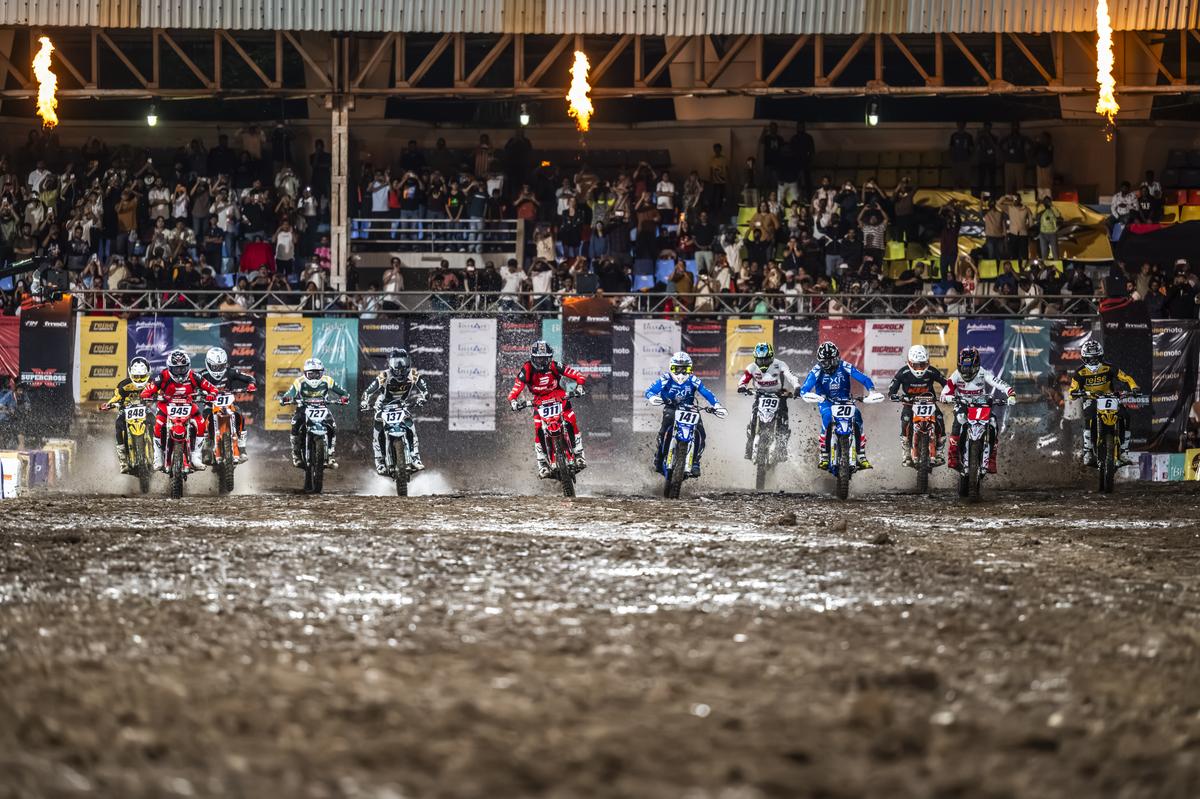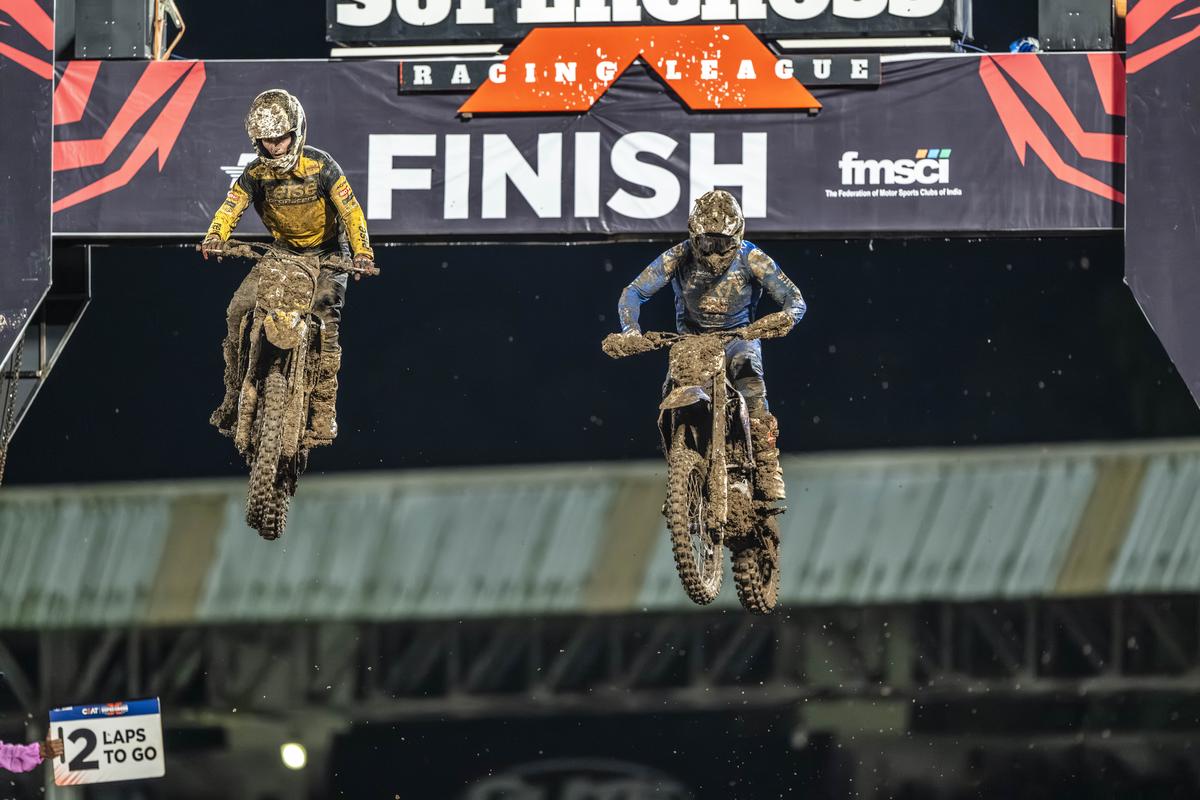Indian Supercross Racing League — A ramp for thrill-seekers to take the big leap
It is a fact that humans cannot fly.
So we came up with other avenues like aeroplanes, hot air balloons, hoverboards and countless contraptions to lift off the ground, be it for just a few seconds or even hours. One such man-made avenue exists not on a runway or a launchpad, but rather on a dirt track.
In supercross, thrill-seekers mount high-torque bikes that help them blaze over the mud before launching themselves into the air, just for a few moments before sinking back into the dirt to go again.
It’s equal part sport, equal part entertainment.
And so when the Indian Supercross Racing League (ISRL) kicked off its second season in Pune on October 26, it was not surprising to see thousands of ‘motorheads’ flock to the Shree Shiv Chhatrapati Sports Complex in Balewadi.

Racers at the start of the Indian Supercross Racing League race.
| Photo Credit:
SPECIAL ARRANGEMENT
Racers at the start of the Indian Supercross Racing League race.
| Photo Credit:
SPECIAL ARRANGEMENT
Once the races began, their cheers were deafened by the high-pitched raspy braaap of the two-wheeled machines. Bits of mud were sent flying in all directions as riders from around the world manoeuvred around the track, with every jump being met with “oohs and aahs” of fascination from the 10,000-odd crowd.
“It was the purest adrenaline rush that I have experienced,” said an excited fan after the races. “I have watched it on television before, but to watch it in person was a fantastic experience,” another added.
Creating India’s own craze
Founded by former riders Veer Patel, Eeshan Lokhande and his brother Aashwin, the ISRL aimed to take a niche sport that they loved and make it a mainstream spectacle.
Its inaugural season in 2024 featured six franchisee teams, with a total of 48 riders, both Indian and international, across five different race categories.
READ | TVS Racing names line-up for Indian National Supercross Championship 2025
The three legs of the season combined drew an attendance of over 30,000 spectators in addition to 11.5 million virtual viewers in just three days of broadcast.
“We wanted to make something that combines racing, entertainment, and fan engagement at the highest level. After one full season, I can confidently say we’ve made a strong step in that direction,” Patel told Sportstar.
A standout characteristic of the Supercross competition is its franchise-based model, making it the first of its kind. After an all Indian lineup last year, this time the league reeled in motorsport giant KTM Racing, which formed a team with Tricolor Motorsports.
According to Patel, this format allows long-term accountability, prompting teams to become contributors in the sport’s success and not just participants.
“State-based models often work for traditional sports, but motorsport is different. Our franchise owners bring strong motorsport, business, and brand backgrounds, which means they understand the discipline, technology, and marketing that go behind each team,” he added.
To add more engagement, fan parks were introduced before the races to allow the fans to get a first-hand view of the pre-race frenzy and interact with the staff and riders of the participating teams.
But while running the operation is one side, the duty of putting on a show and drawing attention rests with the riders.
What makes it ‘super’?
In supercross, the small scale of the track inside a stadium poses big challenges to the riders. They have to wrestle control of hyper-sensitive 450/250cc bikes and constantly take on sweeping turns on walls of dirt.
Each twist of the throttle is a calculated risk, with riders reaching upwards of 20 feet on certain jumps, meaning physical fitness is not up for compromise. The riders undergo intense strength training to develop muscles in their arms and calves to stabilise their vehicles each time the tyres kiss the ground.
However, Indian rider Rugved Barguje, who represents Tricolor KTM in the ongoing competition, admitted that the love for the sport sometimes overshadows the risk factor.

Riders can reach upwards of 20 feet on certain jumps, meaning physical fitness is not up for compromise.
| Photo Credit:
SPECIAL ARRANGEMENT
Riders can reach upwards of 20 feet on certain jumps, meaning physical fitness is not up for compromise.
| Photo Credit:
SPECIAL ARRANGEMENT
Rugved, who is one of only three Indian riders in this edition (a total of 36), also asserted that having the mindset to get back up after a hard crash is key.
“See, there is risk in every game. Go to cricket, you have a risk involved in that. Go to football, everywhere, in any of the sports, there is risk involved,” the 24-year-old Rugved said. “I remember I had a crash after a bike failure, and I was admitted to the ICU because I had a skull injury. But that did not keep me from racing. I just love what I do”
“Whenever I crash, the thing on my mind is why I crashed, what mistake did I make? I want to make sure I don’t make that mistake again. So, I just keep on riding, riding, riding and try to improve myself every lap,” he added.
Climb continues
In India, the lack of practice tracks quite naturally is a downside. And if that was not enough, the expense and inexperience that come along when you decide to pursue supercross as a profession can be overwhelming.
ISRL team Reise TroqRacers’ German rider, Nico Koch, pointed out that, at present, a lot of the emerging riders are those who have associations with motor racing.
“I think the people who start (nowadays) have already connections to the sport, like family-wise, friend-wise,” he said.
Take Rugved, for example. His father, Gnyaneshwar Barguje, was a former national motocross champion, while several other relatives were also riders back in the day. For Rugved, seeing his father race was enough to catch his interest, and with proper guidance, he was eventually able to go pro.
“Watching my dad always motivated me, and even I wanted to do racing, I wanted to fly. In the beginning, I was just riding for fun, but once I started winning and getting more podiums, it went into a career zone,” Rugved said.
But for every Rugved that makes it to the big stage, there are several who fall short.
Through the ISRL, Patel and the Lokhande brothers are overseeing a major chunk of supercross’s development in the country, but the climb continues. And, Patel believes that for upcoming riders, “this is the time to start”.
“Compared to when I raced, the biggest change is the mindset. Riders today believe they can make a career out of it, and that’s huge,” he said.
There is still a long way to go for Indian motorsport in terms of infrastructure, training academies, and exposure. However, for now, the formation of leagues like the ISRL and Indian Superbike League (launched earlier this year) is a gear shift towards success, a ramp for aspiring riders to leap off and keep flying.
Published on Nov 05, 2025



